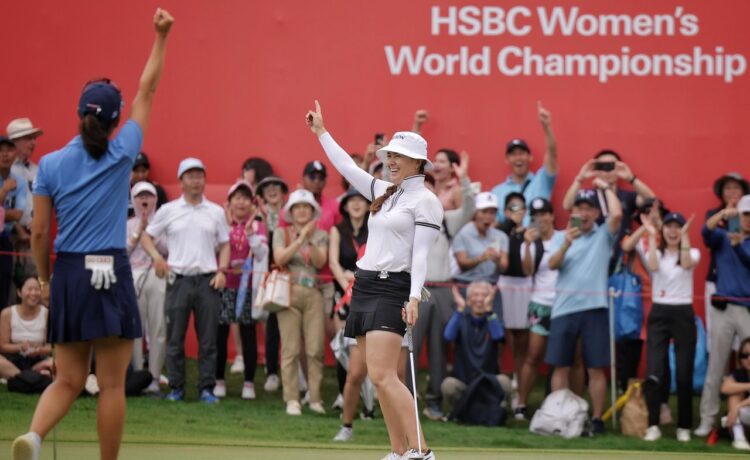GARY Player, one of the most accomplished golfers in the world, once said: “Golf is a game of luck. The more I practise, the luckier I get.”
While luck does play a role in both golf and investing, success ultimately comes down to preparation, discipline, and the ability to adapt.
We saw this unpredictability at the 2024 Paris Olympics, where the women’s golf leaderboard remained wide open after 36 holes – proving that in high-stakes competitions, outcomes are never guaranteed.
Investing is just as uncertain. Markets can swing wildly. Yet, just as golfers refine their game through practice, investors who stay disciplined, keep learning and stick to their strategy tend to create their own luck over time.
Lessons from the course: Drive for show, putt for dough
In women’s golf, precision often trumps raw power. Female golfers may not drive as far as their male counterparts but their controlled, accurate swings minimise penalties – an advantage in scoring consistently.
Investors can learn from this approach. Chasing the best performing trades or market trends may yield quick wins, but disciplined investing, sticking to the fundamentals such as diversification, risk management and long-term planning, typically delivers stronger results over time.
BT in your inbox

Start and end each day with the latest news stories and analyses delivered straight to your inbox.
Studies show that women investors, who tend to be more patient, disciplined, and risk-aware, achieve better long-term investment outcomes, proving that a steady, thoughtful approach outperforms impulsive moves.
As another golfing legend, Jack Nicklaus, once said: “A good player who is a great putter is a match for any golfer. A great hitter who cannot putt is a match for no one.”
In investing, it’s not about taking the biggest swings (or the biggest bets). Rather, it’s about mastering the details, managing risks and ensuring that every move aligns with your long-term goal.
Getting out of the rough: The case for balanced risk
A skilled golfer approaches each shot strategically – evaluating wind speed, hazards and terrain. Fixating on distance alone can land the ball in a bunker. The smarter play is often a well-placed layup that positions the player for a better next shot.
Investing is no different. Some investors chase higher risks in hopes of quick gains. Others play too conservatively, avoiding necessary risks and falling short of their long-term financial goals – all of which are suboptimal.
The best approach, like in golf, is a balanced strategy of growth and income that considers one’s risk tolerance and financial objectives.
Younger investors, like golfers in the early stages of a tournament, can afford longer drives and more aggressive plays. Time is on their side to recover from setbacks. Near-retirement investors, playing the “final holes”, should prioritise stability and income preservation.
Teeing up for global diversification
No golfer relies on a single club for every shot. Drivers, irons, and putters each serve a specific purpose. Similarly, a well-constructed investment portfolio blends different assets – stocks for growth, bonds for stability, alternatives for diversification, and cash for liquidity.
We’ve all heard stories of entrepreneurs becoming very successful because of large, concentrated bets in a particular sector or asset class. Their success can be attributed to a strong local knowledge of their country and sector.
However, their strength could turn out to be a weakness as such a strategy is an impediment for investment returns when it comes to wealth preservation for the long haul.
Diversification remains one of the most reliable hedges against uncertainty. By spreading investments across asset classes, geographies, and sectors, investors can reduce the impact of isolated events or trends.
However, diversification strategies must evolve to reflect shifting market dynamics. Historical correlations are shifting. For instance, the once-reliable negative correlation between equities and bonds has become less predictable in an era of persistent inflation and elevated interest rates.
Investors today should consider alternatives such as private markets and real assets for uncorrelated returns; thematic investments in growth trends such as artificial intelligence, cloud infrastructure and semiconductors; and emerging markets for opportunities beyond high US valuations.
As with golf, the key is knowing when to switch clubs – using the right asset for the right market condition.
Staying the course
Winning a golf tournament isn’t about one brilliant shot but consistent performance across every round. Mistakes happen, but the best golfers recover, adapt, and keep their eyes on the prize.
The same principle applies to building wealth. Investing isn’t about timing the market but time in the market. It requires steady, disciplined decisions over years, often decades.
In both golf and investing, success comes down to a few things. First, choose the right shot, not just the longest one. Second, diversify your portfolio – just like how a golfer uses different clubs to tackle different challenges. And third, take calculated risks and balance growth opportunities with protection against losses.
Preparation, patience, and discipline create more than luck. They create lasting success.
The writer is chief investment officer of South-east Asia and India, HSBC. The HSBC Women’s World Championship is taking place from Feb 27 to Mar 2 at Sentosa Golf Club.

